www.GemstoneBasics.com
Photomicrography > Corundum > Metamorphic rubies & sapphires
First draft: May 15th, 2014 | Last update: June 14th, 2016
Some Features Observed in Metamorphic Rubies & Sapphires
Greenland, Mozambique, southern Madagascar,
Myanmar (Burma), Sri Lanka (Ceylon), Tanzania & northern Vietnam
Metamorphism is a geological process in which pre-existing or parent rocks recrystallise following changes either in temperature and pressure or by rock-fluid interaction (metasomatism). Fluids usually contain chemicals that may mobilise other elements to participate in the recrystallisation process.
The main geological processes triggering parent rock recrystallisation and injection of fluids include tectonic activity and magmatic intrusions, implying that parent rocks may even melt prior to recrystallisation - a process called anatexis. The latter lays a foundation for the formation of magmatic corundum.
The basic requirement for corundum formation is a parent rock rich in aluminium, Al, depleted of or poor in silicon, Si, and containing the necessary chromophores. Consequently, a wide variety of rocks are candidates, while intrusions or fluids may facilitate further depletion of Si: desilicification.
Subjected to metamorphic Amphibolite facies (650°C; 4.5-6.5 kbar) or Granulite facies (700-750°C; 8-10.5 kbar) conditions, Nature created gems from the parent rocks' mineral assemblages with a geochemistry and inclusion scene that is completely different from rubies and sapphires of magmatic origin.
References and items of related interest
Collins, A.S. (2000). The tectonic evolution of Madagascar: Its place in the East African Orogen. Gondwana Research, Vol. 3, No. 4, pp. 549–552.
Cooray, P.G. (1984). An introduction to the geology of Sri Lanka. 2nd Revised Edition, National Museums of Sri Lanka, Colombo, xix, 340 p. + geological map (1 : 500.000). review
Dahanayake, K. (1980). Modes of occurrence and provenance of gemstones of Sri Lanka. Mineralium Deposita, Vol. 15, Issue 1 (March), pp. 81-86. abstract + references
Dahanayake, K. & Ranasinghe, A.P. (1981). Source rocks of gem minerals: a case study from Sri Lanka. Mineralium Deposita, Vol. 16, Issue 1 (May), pp. 103-111. abstract + references
Dahanayake, K. & Ranasinghe, A.P. (1985). Geology and mineralogy of gemming terrains in Sri Lanka. Bulletin of the Geological Society of Finland, Vol. 57, Part 1-2, pp. 139-149.
Dissanayake, C.B. & Chandrajith, R. (1999). Sri Lanka–Madagascar Gondwana Linkage: Evidence for a Pan-African Mineral Belt. The Journal of Geology, Vol. 107, p. 223–235.
Dissanayake, C.B., Chandrajith, R. & Tobschall, H.J. (2000). The Geology, Mineralogy and Rare Element Geochemistry of the Gem Deposits of Sri Lanka. Bulletin of the Geological Society of Finland, Vol. 72, No. 1-2, pp. 1-20. Also see www.geologinenseura.fi
Garnier, V., Giuliani, G., Ohnenstetter, D. & Schwarz, D. (2004). Saphirs & Rubis, Les gisements de corindon: classification et genese. Le Regne Mineral, No. 55, 47 p (in French).
Garnier, V., Ohnenstetter, D., Giuliani, G. & Schwarz, D. (2003). Revue des classifications des gisements de corindon. Chapitre 4, Ecole Doctorale RP2E, France (in French).
Giuliani, G., Ohnenstetter, D., Fallick, A.E., Groat, L. & Fagan, A.J. (2014). The geology and genesis of gem corundum deposits In: Groat, L.A. (Editor) Geology of gem deposits, pp. 29-112. Mineralogical Association of Canada, Short Course Series, Vol. 44, Quebec, Quebec, Canada, 405 p. ISBN 978-0-921294-54-2.
Gübelin, E.J. (1983).
The Precious Corundums Ruby and Sapphire In: Internal World of Gemstones. Documents from Space and Time, pp. 112-136.
3rd edition. ABC Edition, Zürich, Switzerland, 234 p. ISBN 3-85504-030-3.
Note: 1st Edition (1973). Innenwelt der Edelsteine. Urkunde aus Raum und Zeit.
ABC Edition, Zürich, Switzerland, 233 p. ISBN 3-85504-030-3 (in German; ISBN checked in the original copies).
Gübelin, E.J. & Koivula, J.I. (1997). Ruby and Sapphire and their Inclusions In: Photoatlas of Inclusions in Gemstones, pp. 324-361. 3rd revised edition. ABC Edition, Zürich, Switzerland, 532 p., ISBN 3-85504-095-8.
Gübelin, E.J. & Koivula, J.I. (2008). Inclusions in Major Commercial Gems: Ruby and Sapphire In: Photoatlas of Inclusions in Gemstones. Volume 3, pp. 53-353. Opinio Publishers, Basel, Switzerland, 672 p., ISBN 3-03999-029-2.
Groat, L.A. (2014). Geology of Gem Deposits. 2nd Edition. Short Course Series, Vol. 44. Mineralogical Association of Canada, Québec, Québec, Canada, 405 p. ISBN 978-0-921294-54-2. Mineralogical Association of Canada
Hänni, H.A. (1994). Origin determination for gemstones: possibilities, restrictions and reliability. The Journal of Gemmology, Vol. 24, No. 3, pp. 139-148. Also published on www.ssef.ch
Hunstiger, C. (1990). Darstellung und Vergleich primärer Rubinvorkommen in metamorphen Muttergesteinen, Part I: Petrographie und Phasenpetrologie. Gemmologie: Zeitschrift der Deutschen Gemmologischen Gesellschaft, Vol. 38, No. 4, pp. 113-138 (in German).
Hunstiger, C. (1990). Darstellung und Vergleich primärer Rubinvorkommen in metamorphen Muttergesteinen, Part II: Petrographie und Phasenpetrologie. Gemmologie: Zeitschrift der Deutschen Gemmologischen Gesellschaft, Vol. 39, No. 1, pp. 49-63 (in German).
Hunstiger, C. (1990). Darstellung und Vergleich primärer Rubinvorkommen in metamorphen Muttergesteinen, Part III: Petrographie und Phasenpetrologie. Gemmologie: Zeitschrift der Deutschen Gemmologischen Gesellschaft, Vol. 39, No. 2/3, pp. 121-145 (in German).
Kievlenko, E.Y. (2003). Geology of Gems. English Ed., Ocean Pictures Ltd., Littleton, CO, USA, 432 p. + 32 p. plates. ISBN 978-5900395258.
Koltsov, A.B. (2002). Ruby-bearing metasomatites in marbles: conditions and numerical model of the formation. Experiments in Geosciences, Vol. 10, pp. 94-96.
Larsen, E.S. (1928). A hydrothermal origin of corundum and albitite bodies. Economic Geology, Vol. 23, No. 4, pp. 398-433.
Peucat, J.-J., Ruffault, P., Fritsch, E., Simonet, C., Bouhnik-Le Coz, M. & Lasnier, B. (2005). Un nouvel outil géochimique de reconnaissance des saphirs bleus basaltiques et métamorphiques: le rapport Ga/Mg. Revue de Gemmologie, Association Française de Gemmologie, No. 153, pp. 8-12 (in French).
Schmetzer, K. (1986). Natürliche und synthetische Rubine: Eigenschaften und Bestimmung. E. Schweizerbart'sche Verlagsbuchhandlung, Stuttgart, Germany, 131 p. ISBN 3-510-65125-1 (in German).
Schwarz, D. (1998). Aus Basalten, Marmoren und Pegmatiten. Spezielle Ursachen form ten in der Erdkruste edle Rubine und Saphire In: Glas, M. (Editor) Rubin, Saphir, Korund: schan, hart, selten, kostbar. extraLapis, No. 15, pp. 5-9. Christian Weise Verlag, München, Germany, 96 p. ISBN 9-921656-45-1 (in German).
Simonet, C. (1997). Géologie des Gisements de Saphirs. Diplôme d'Université de Gemmologie (DUG) Dissertation, University of Nantes, 82 p. (in French). Published on www.gemnantes.fr
Silva, K.K.M.W. & Siriwardena, C.H.E.R. (1988). Geology and the origin of the corundum-bearing skarn at Bakamuna, Sri Lanka. Mineralium Deposita, Vol. 23, Issue 3 (July), pp. 186-190. abstract + references
Sorkhabi, R.B. & Stump, E. (1993). Rise of the Himalaya: A geochronologic approach. GSA Today, Vol. 3, No. 4, pp. 85, 88-92.
Sutherland, F.L. & Schwarz, D. (2003). Origin of gem corundums. The Journal of Gemmology, Vol. 28, No. 8, pp. 473-452.
Vernon, R.H. & Clarke, G.L. (2011). Principles of Metamorphic Petrology. 3rd Printing. Cambridge University Press, New York, N.Y., U.S.A., 446 p. ISBN 978-0-521-87178-5.
Wade, S. (2002). Origin blues. Colored Stone, Vol. 15, No. 3, pp. 38-39.
Zaw, K., Sutherland, L., Graham, I. & McGee, B. (2008). Dating zircon inclusions in gem corundums from placer deposits, as a guide to their origin. 33rd International Geological Congress, Oslo, August 6-14th. abstract
Photomicrographs
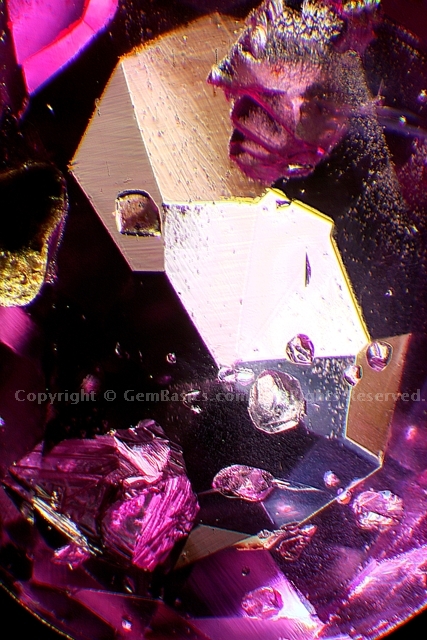
Crystal inclusions in a 0.75ct Sri Lankan sapphire
25x (FoV ± 3mm) Obl, Pol
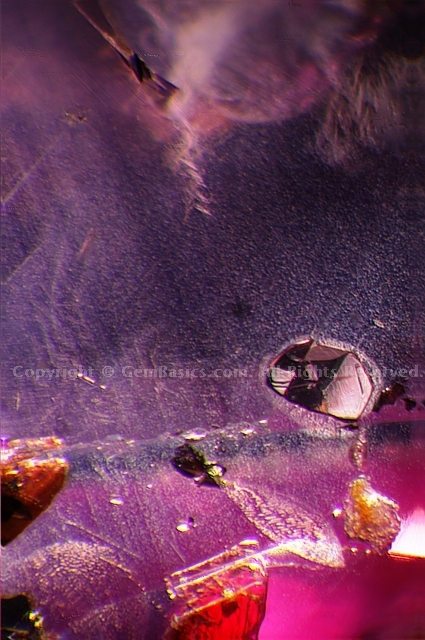
Crystal inclusions in a 0.77ct Sri Lankan sapphire
50x (FoV ± 2mm) Obl, Pol
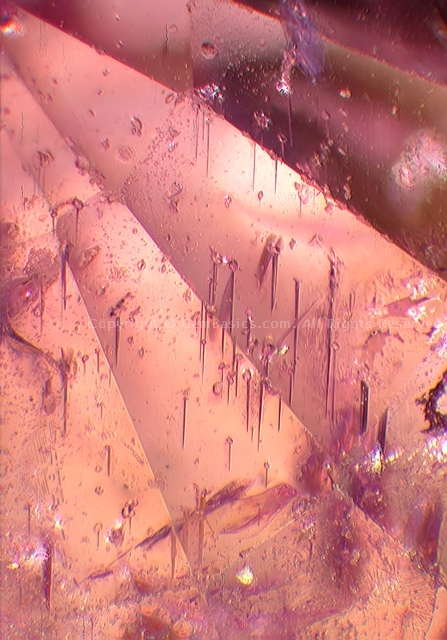
Nail head spicules (!) in a 1.04ct Sri Lankan sapphire
40x (FoV ± 3mm) Obl, Pol

Apatite inclusions in a sapphire from southern Madagascar
25x (FoV ± 3mm) Obl, Pol
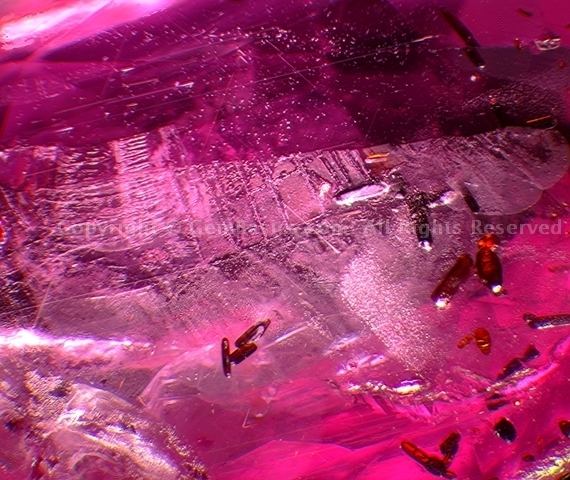
Rutile inclusions can be worn or uncorroded like in this 0.48ct ruby
25x (FoV ± 3mm) Obl, DF, Pol
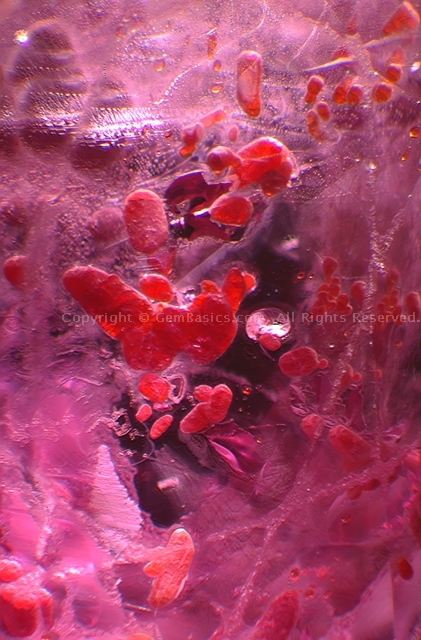
Protogenetic rutile is often corroded
25x (FoV ± 3mm) Obl, DF, Pol
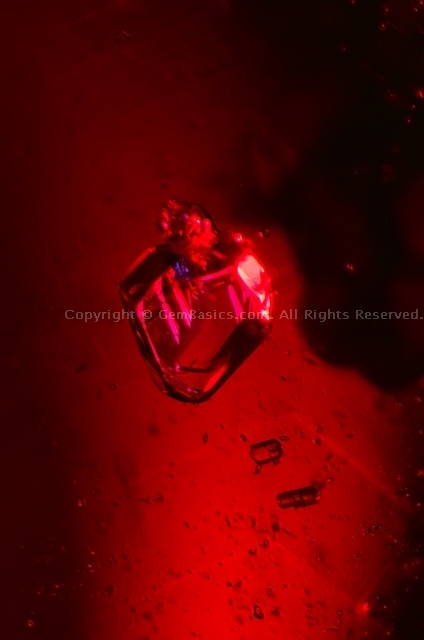
Calcite, resembling a heart in Burma ruby
50x (FoV ± 1.5mm) Obl, Sh, Pol
 Serie 1 - DS, Sh E, Sm.jpg)
Unidentified inclusion in a 1.65ct Winza ruby
50x (FoV ± 2.0mm) Obl, Sh, Pol
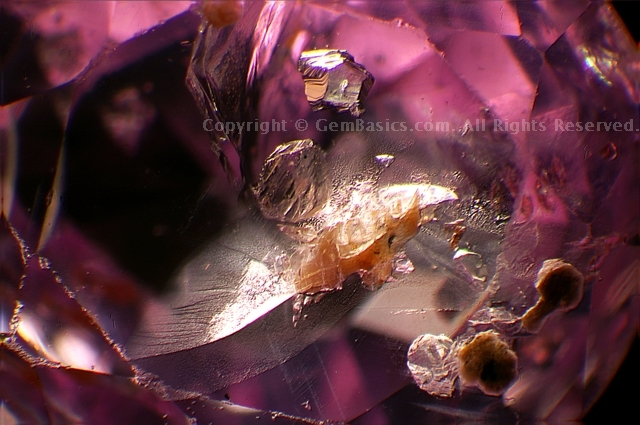
This kind of inclusion scene is immediately reminiscent of a metamorphic origin
20x (FoV ± 4.0mm) Fiber illumination, DF
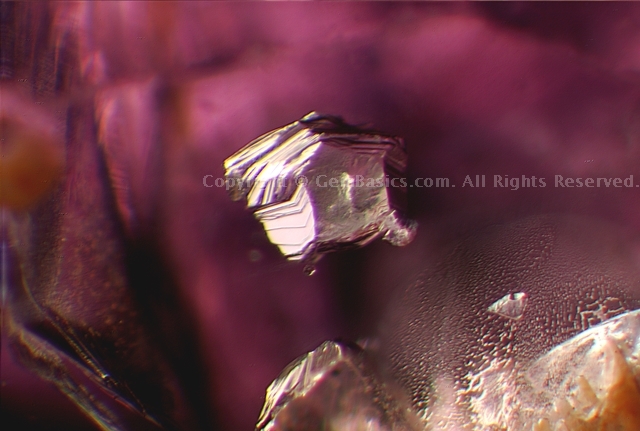
Negative inclusions are growth defects that can attain dramatic shapes...
50x (FoV ± 1.5mm) Fiber illumination, DF
 - DSS Sel AC IJ Sh NE Sm B10,C60,M-10.jpg)
... such as this apocalyptic scene in a Sri Lankan sapphire
40x (FoV ± 2.5mm) Fiber illumination, DF
 - DSS AB, Sat 35 IJ Sh SW Sm 2.jpg)
The 2.02ct sapphire crystal further hosts this peculiar inclusion which is oxidised due to heat treatment
50x (FoV ± 2.0mm) Obl
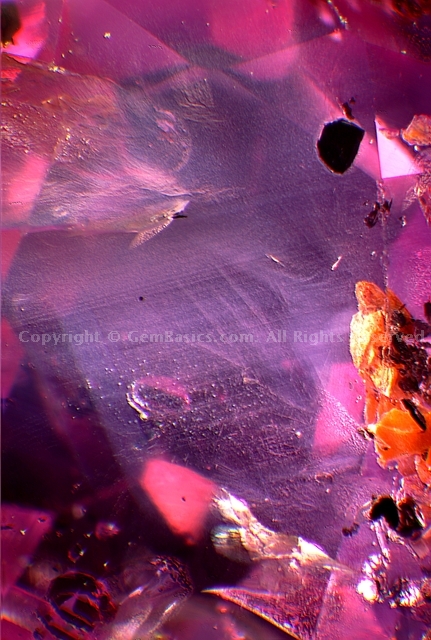
Rutile occurs in many forms: as dust subtly diffused...
25x (FoV ± 3.0mm) Obl, Sh, Pol
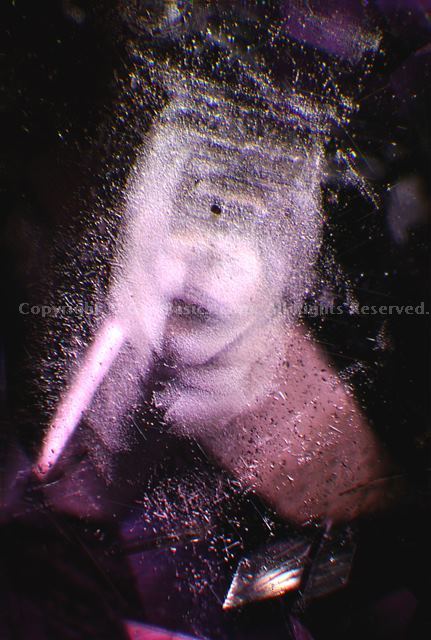
... or in extremely dense clouds...
25x (FoV ± 3.0mm) Fiber illumination
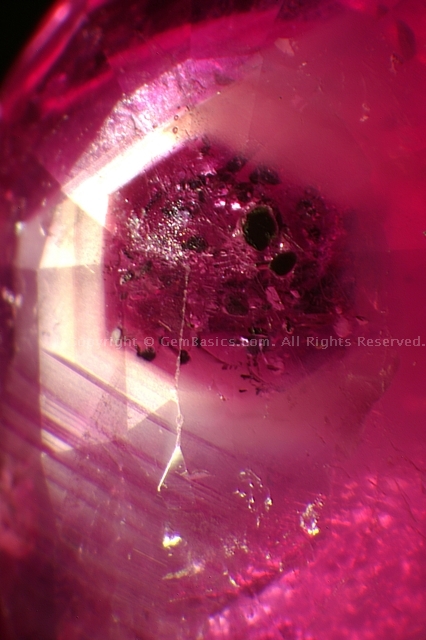
... yet mostly following crystallographic directions
18x (FoV ± 4.0mm) Fiber illumination
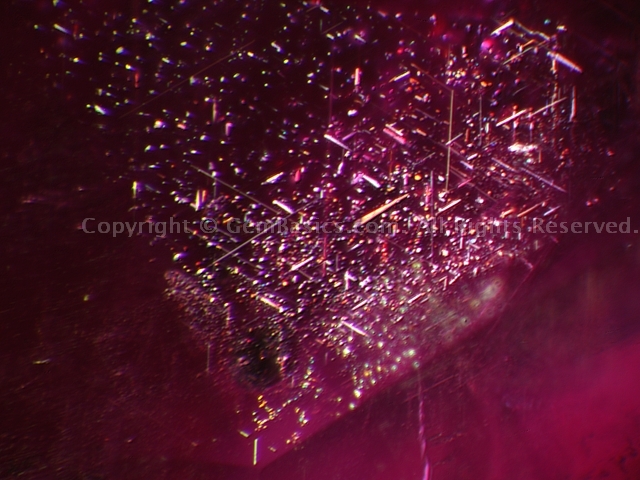
Rutile needle twins (aka as "arrow heads") in a 2.78ct unheated Sri Lankan ruby...
40x (FoV ± 2.5mm) Fiber illumination
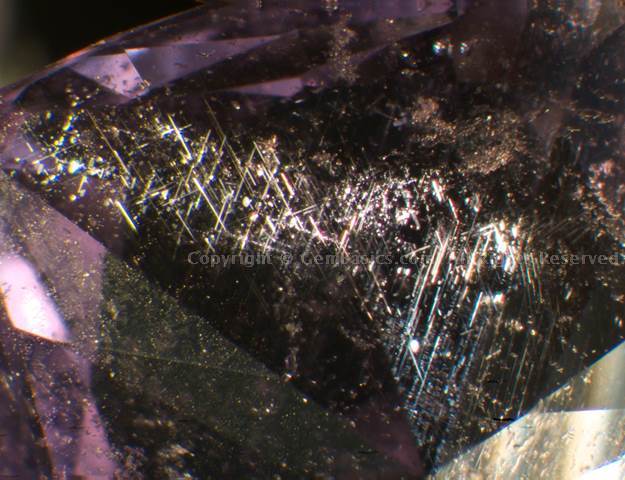
... are also observed in this 2.18ct Madagascan colour-changing sapphire
9x (FoV ± 3.5mm) Fiber illumination
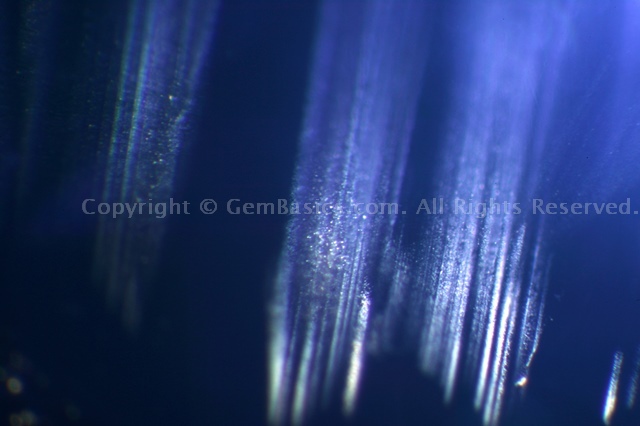
Rutile silk bands in an unheated 5.50ct Sri Lankan sapphire
18x (FoV ± 12.0mm) Obl, Sh, Pol
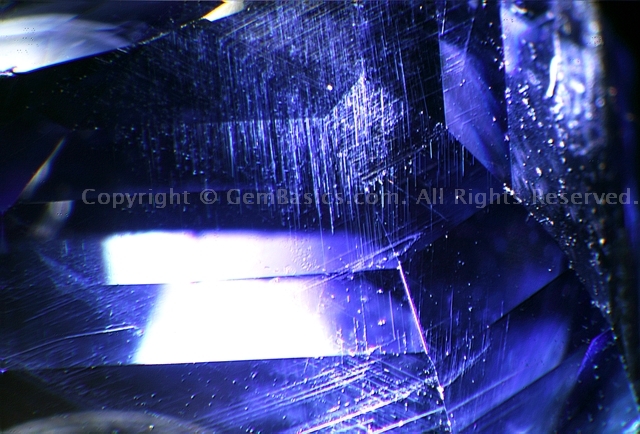
Rutile needles in an 18.43ct unheated Sri Lankan sapphire
12x (FoV ± 3.5mm) Obl, Sh, Pol
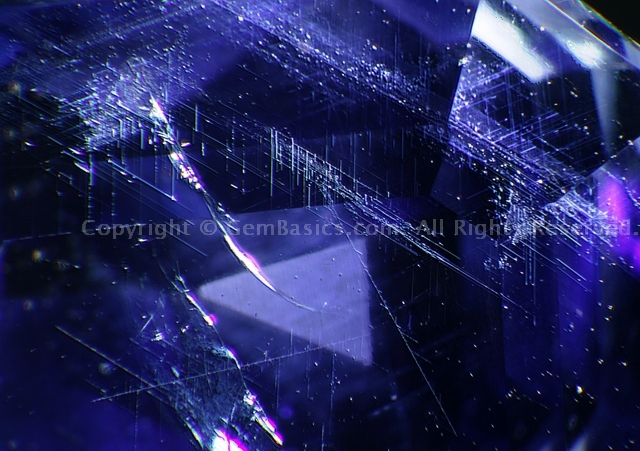
Intersecting rutile needles seen in the same sapphire
12x (FoV ± 7.0mm) Obl, Sh, Pol
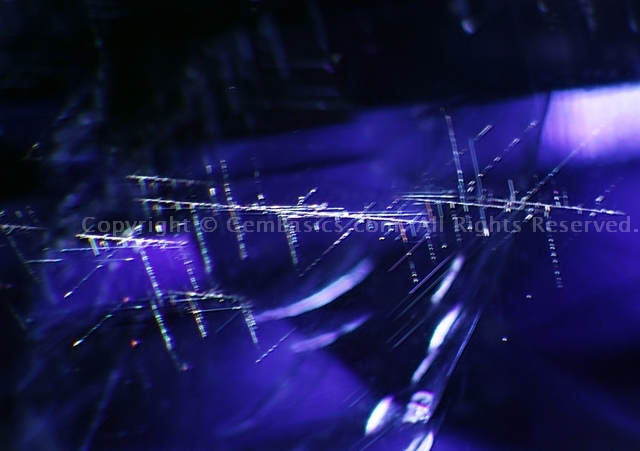
And yet another view of these intricate entwinings
40x (FoV ± 3.5mm) Obl, Sh, Pol
